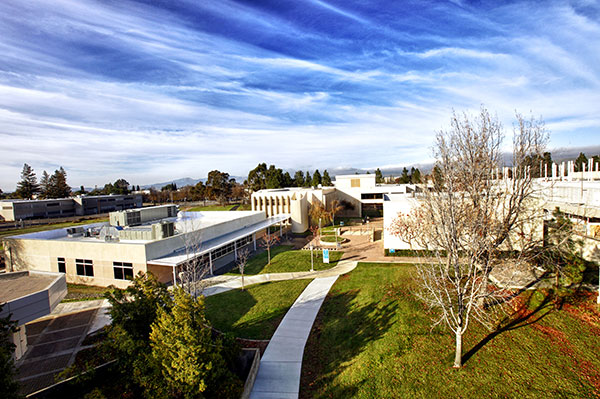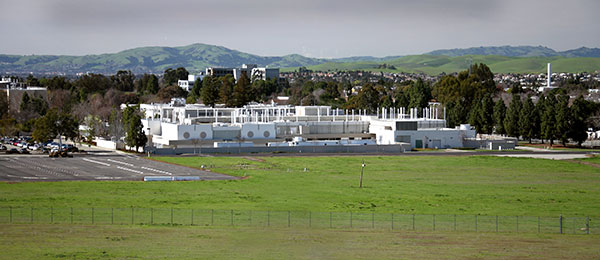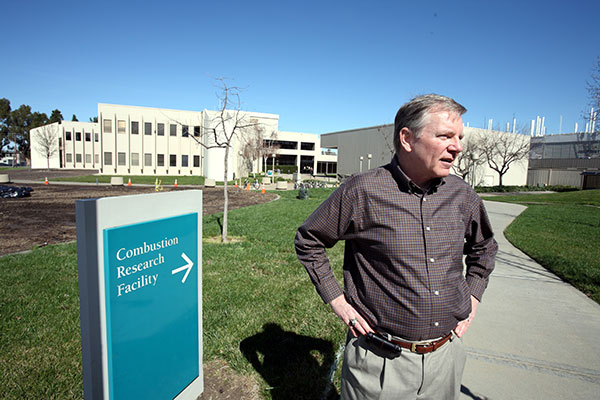
The weather on March 6, 1981, was nothing too remarkable for the San Francisco Bay Area — a little drizzle with temperatures in the 50s and a fairly calm wind.
The remarkable event of that day was taking place on Sandia’s California campus, but even those who participated in the opening of the newly built Combustion Research Facility had no idea how much it would change the world.
CRF in the beginning
“It was designed to provide an understanding of combustion in response to the energy crisis,” senior manager Craig Taatjes explained, referring to the oil embargo by members of the Organization of the Petroleum Exporting Countries that drove a surge in gasoline prices and a supply shortage in the United States. At that time, the nation grown increasingly dependent upon imported oil and needed to find ways to be more energy self-sufficient.
“The other part of the vision was that it be a collaborative facility where researchers from around the world could participate, teach us and learn from us,” said Craig, who supervises the center’s physical sciences efforts. “One of the big visions was to bring together the applied offices and fundamental offices in one place.”
“There are diagnostics and scientific measurement approaches developed and really understood deeply in the more fundamental side of the CRF that then are brought over and applied to more complex problems in the engines program,” added Director Sarah Allendorf, head of the Chemistry, Combustion and Materials Science Center that manages CRF.
Senior manager Chris Shaddix, who heads energy and transportation sciences, expanded on the benefits of having applied science researchers and fundamental scientists under one roof.
“The applied people too would sometimes modify techniques, out of necessity, to make them work in their environment,” Chris said. “That would lead to new insights that were useful to doing more fundamental studies. That was a common thread.”
Center of innovation

Sarah and her senior managers rattled off a list of technological advances that didn’t exist before researchers at CRF invented or began using them in new ways. Ion imaging, developed in the late 1980s at the California facility, uses powerful lasers to ionize gas molecules and projects the resultant ions onto a two-dimensional detector. The position that the ions strike on the detector reflects the speed and direction the molecules were traveling when they were ionized, which can be used to understand the details of the chemical reactions that formed the molecules. The technique was a new way to understand fundamental chemical physics processes that had never been documented.
“That ion imaging is used in hundreds of labs around the world now,” Sarah pointed out, “and is a foundation for other types of experiments that have expanded our understanding of gas phase chemistry.”
Other technologies also developed at CRF include the Chemical Kinetics, or CHEMKIN, software package written to calculate combustion chemistry and now used by industry around the world; a process called Rapid Reduction of Nitrogen Oxides to help clean up engine emissions; and use of photo-ionization mass spectrometry to unravel complex combustion chemistry and atmospheric chemistry.
“And most recently ducted fuel injection is the big one,” Craig said of the technology being developed by researcher Charles Mueller to fine-tune the fuel-air mixture in diesel engines by controlling the flow of fuel into the combustion cylinder.
“It’s offering essentially an elimination of soot from diesel engines, which would be a huge, huge breakthrough,” Chris said.
Overcoming early challenges
In the early days, it was a challenge to convince others to adopt the technologies and data that came from CRF. Bob Carling spent 38 years at Sandia, 27 of them doing work in the facility, and he recalls the first decade.
“It took a while for the engine companies to really understand the value of what we can provide them as they design these engines. I think they saw us early on as a novelty,” he said. “As time went on, they became more and more dependent upon understanding what was going on inside the cylinder which we were uncovering.”
“It’s safe to say that every group of researchers that’s ever been at CRF has essentially been world leaders at what they do.”
The main strength of CRF is the people who work within its labs, who come to Sandia from across the globe to tackle global issues, drawing inspiration from one another.
“It’s safe to say that every group of researchers that’s ever been at CRF has essentially been world leaders at what they do. We expect that actually at CRF. After a few years at Sandia, we expect you to be a world leader at what you do,” Chris said.
Sarah and Bob both emphasized the importance of bringing international researchers to CRF.
“We work collaboratively. We engage with the science community,” Sarah said. “We have been very intentional around bringing in the international community.”
Bob said, “Climate change is a worldwide problem,” adding that he championed the Livermore Open Campus where the CRF sits so that they could bring in the best minds from around the world.
Industry partnerships lead to real change

Bob, who was the CRF director for the last five years of his career, said part of the center’s success was the visible results researchers were generating.
“One of the things we always emphasized was trying to find ways to publish our information,” he said. “The work they were doing was fundamental science that every car manufacturer in the world should incorporate into their engine designs.”
Sarah was also quick to point to the business partnerships that have driven innovation across several industries over the last four decades, including auto making, steel, glass and energy production.
“They do work in their own labs, where we’ve done the pre-competitive research that is shared publicly, and they will go do specialized, proprietary research,” she said. “The state of American industrial research has changed massively in the last 40 years. Many of those industries had their own research labs that we would complement. Many of those research labs just don’t exist anymore. Our pre-competitive work allows our industrial partners to focus their precious research dollars on the pieces that is their competitive advantage.”
CRF down the road
All of this is just the tip of the iceberg keeping the CRF relevant in the 21st century and driving future innovations.
“There are still unsolved problems. It’s been a continual evolution and some of these advanced technologies give us a very detailed understanding of all the internal processes going on that we really had no idea of 40 years ago,” Chris said. “In recent years there’s been a new understanding and new approach to combustion engines that actually look promising for making significant gains in efficiency. The new engine technologies that some researchers at CRF are working on could get at least 30-40% more efficiency out of engines than any existing technology.”
CRF’s research and people have shaped industrial development, the nation and the world for decades.
“Over the past 40 years, the CRF has delivered ‘exceptional service in the national interest’,” said Andy McIlroy, Associate Labs Director of Integrated Security Solutions, who began his Sandia career in the CRF and now leads the Sandia division that houses it, “providing the technical basis for dramatic reductions in criteria pollutants and increased fuel efficiency of combustion systems, in turn leading to improved community health, lower environmental impact and improved energy security for the nation. I’m proud to have been part of that history and look forward next generation of exceptional accomplishments.”
For Sarah, CRF has grown well beyond the mission first envisioned for it. “We have a reputation and that’s our brand. Our reputation is one of innovation, collaboration and the constant addressing of new challenges,” she said.
“There isn’t a single modern vehicle on the road today that hasn’t benefitted from the work done at the CRF,” Bob said.